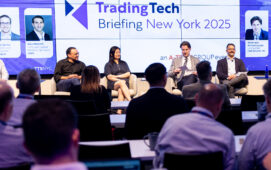Trading complex financial products on behalf of a large enterprise is an elaborate challenge that requires distributed systems working together. Broadway Technology, a provider of middleware serving electronic trading and automated decision-making needs, offers TOC, a platform addressing that problem. Intelligent Trading Technology spoke with Joshua Walsky, the company’s chief technology officer, about how TOC works, and how it may prove particularly useful for MiFID II compliance.
Broadway Technology began in 2003 by commercialising technology that Walsky and Tyler Moeller, CEO and co-founder, had built at KATS Trading, a proprietary trading firm. The company has continued to build on this technology and update it over time, adding elements such as shared memory to lower latency, new network cards and coverage of multiple asset classes. Its clients include large sell-side firms and their front-office trading desks, as well as some buy-side firms and clients of larger institutions who are local market makers for particular securities.
TOC addresses complex financial products like derivatives, and complex related identifying data such as value-at-risk computations and legal entity mappings, according to Walsky. “Broadway started in one of the harder domains in fixed-income, which has a complex set of requirements that demand a sophisticated infrastructure,” he says. “We started there and built a truly asset class-agnostic system.”
Getting distributed systems to work together also means getting distributed coordination and collaboration between their components and users, according to Walsky. “Consider the user’s perspective of a system. You start with the screen but without back-end flexibility and API openness that is where many trading systems end,” he says. “With the TOC, you can do your trading from the screen interface and also build what you want on the back-end or as a custom front-end to extend it.
“TOC is focused on integration, collaboration and workflow,” he adds. “Algorithms and components can collaborate with users, for example, to notify a trader to change parameters because the fill isn’t what they expected. By facilitating that interaction and integration between systems and people, you can handle complex trading and business workflows. Ultimately all front-office automated and electronic trading is really business workflow performed at an incredibly optimised and fast pace.”
Broadway’s TOC system can link pricing data for an instrument to relevant models, and also allows users who can program in standard languages such as Java, C#, Python or C++ to build a pricing engine for particular asset classes or instruments. This flexibility for customisation by users ensures that the system evolves and stays agile over time, Walsky explains.
In the time remaining before MiFID II takes effect, Broadway Technology will continue to work with its customers on the compliance needs it can best address, according to Walsky. “With MiFID II reshaping technology requirements in Europe, a lot of the industry is figuring out what it needs to do. In addition to meeting the regulatory requirements, Broadway’s view is that it is essential to be agile,” he says. “Right up to the first deadline, that’s very important because you have certain obligations you need to meet. Immediately following that deadline, agility will allow firms to react to new opportunities as they present themselves in the changed market structure.”
After January 3, 2018, trading styles and methods are likely to change, as a result of MiFID II implementation, Walsky believes. The agility and flexibility that Broadway offers in TOC will “come into play” more next year as a result, he says.
Subscribe to our newsletter




